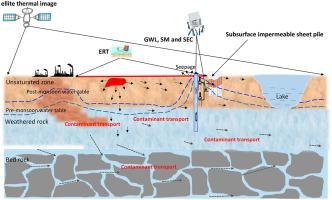Environmental Pollution ( IF 7.6 ) Pub Date : 2020-11-27 , DOI: 10.1016/j.envpol.2020.116165 L. Surinaidu , M.J. Nandan , D.K. Sahadevan , A. Umamaheswari , V.M. Tiwari

|
Perennial contaminated groundwater seepage is threatening the downstream ecosystem of the Kazipally Pharmaceutical industrial area located in South India. The sources of seepage are unknown for the last three decades that challenging the regulatory authorities and industries. In general, water quality monitoring and geophysical techniques are applied to identify the sources. However, these techniques may lead to ambiguous results and fail to identify the seepage sources, especially when the area is urbanized/paved, and groundwater is already contaminated with other leakage sources that have similar chemical compounds. In the present study, a novel and multidisciplinary approach were adopted that includes satellite-based Land Surface Temperature (LST) observations, field-based Electrical Resistivity Tomography (ERT), continuous Soil Electrical Conductivity (SEC) and Volumetric Soil Moisture (VSM%) measurements along with groundwater levels monitoring to identify the sources and to control the seepage. The integrated results identified that the locations with the Standard Thermal Anomaly (STA) in the range of -0.5 to -1oC, VSM% >50%, SEC > 1.5 mS/cm, bulk resistivity < 12 Ω.m with shallow groundwater levels < 3 m below ground level (bgl) are potentially contaminated perennial seepage sources. Impermeable sheet piles have been installed across the groundwater flow direction to control the seepage up to 1.5 m bgl, where groundwater frequently intercepts land surface. The quantity of dry season groundwater seepage has been declined by 79.2% after these interventions, which in turn minimized the treatment cost of 1,96,283 USD/year and improved the downstream ecosystem.
中文翻译:

印度南部高度工业化流域的多年生受污染地下水渗漏源识别和管理
多年生被污染的地下水渗漏正在威胁位于印度南部的Kazipally Pharmaceutical工业区的下游生态系统。在过去的三十年中,渗漏的来源未知,这挑战了监管机构和行业。通常,水质监测和地球物理技术可用于识别水源。但是,这些技术可能会导致结果含糊不清,并且无法识别渗流源,尤其是当该地区已城市化/铺砌且地下水已被具有类似化学物质的其他泄漏源污染时。在本研究中,采用了一种新颖的多学科方法,包括基于卫星的陆面温度(LST)观测,基于现场的电阻率层析成像(ERT),连续土壤电导率(SEC)和土壤体积水分(VSM%)测量以及地下水位监测,以识别水源并控制渗流。综合结果表明,在浅层地下水中,标准热距平(STA)的位置在-0.5至-1 o C,VSM%> 50%,SEC> 1.5 mS / cm,体电阻率<12Ω.m低于地面(bgl)3 m以下的水平可能是多年生的潜在污染源。沿地下水流向安装了不可渗透的板桩,以控制高达1.5 m bgl的渗漏,在该渗漏中,地下水经常会拦截陆地表面。经过这些干预,枯水期地下水的渗入量下降了79.2%,从而使每年1,96,283美元的处理成本降至最低,并改善了下游生态系统。











































 京公网安备 11010802027423号
京公网安备 11010802027423号